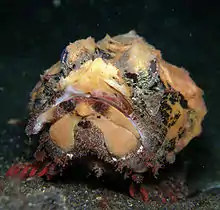Scorpaenopsis diabolus
Scorpaenopsis diabolus, the false stonefish or the devil scorpionfish,[2] is a carnivorous ray-finned fish in the order Scorpaeniformes, the scorpionfishes and flatheads. It has venomous spines and lives in the tropical Indian and Pacific Oceans. It is a bottom-dwelling predator that relies on its camouflage to catch passing prey.
| Scorpaenopsis diabolus | |
|---|---|
 | |
| Scientific classification | |
| Kingdom: | |
| Phylum: | |
| Class: | |
| Order: | |
| Family: | |
| Genus: | |
| Species: | S. diabolus |
| Binomial name | |
| Scorpaenopsis diabolus (Cuvier, 1829) | |
Description


The false stonefish has a broad head with a wide mouth, a humped back, and a tapering body, and can reach 30 cm (12 in) in length.[2] Its dorsal fin has 12 venomous spines and eight to 10 soft rays. The anal fin has three spines and five to six soft rays. The skin is rough with low conical projections, spines, and tassels. The colouring is a combination of mottled grey and white with reddish-brown blotches and the fish is well-camouflaged among stones and corals. The inner sides of the broad pectoral fins have orange, black, and white blotches and the fins can be "flashed" as a warning. This fish closely resembles the reef stonefish (Synanceia verrucosa).[3][4]
S. diabolus exhibits biofluorescence, that is, when illuminated by blue or ultraviolet light, it re-emits it as red, and appears differently than under white light illumination. Biofluorescence may assist in intraspecific communication and camouflage.[5]
Distribution and habitat
The false stonefish is found at depths to about 70 m (230 ft) in the Indian and Pacific Oceans. Its range extends from South and East Africa and the Red Sea to Japan, Hawaii, French Polynesia, Australia, and New Caledonia. It is found on the seabed among rubble, seaweed-covered rocks or on rocks encrusted with coralline algae on reef flats, lagoons, and the seaward side of reefs.[3]
Biology
The false stonefish is a bottom-dwelling fish and is sometimes partially covered with sediment. It is an ambush predator and feeds on passing prey such as invertebrates and small fish.[4] It flares its pectoral fins as a warning if disturbed by a potential predator. Its venomous dorsal spines can inflict a painful wound.[3]
References
- Motomura, H. & Matsuura, K. 2016. Scorpaenopsis diabolus. The IUCN Red List of Threatened Species 2016: e.T69918624A70009965. https://dx.doi.org/10.2305/IUCN.UK.2016-3.RLTS.T69918624A70009965.en. Downloaded on 20 July 2020.
- "False Stonefish, Scorpaenopsis diabolus (Cuvier, 1829)". Australian Museum. Retrieved 2014-01-07.
- "Scorpaenopsis diabolus (Cuvier, 1829): False stonefish". FishBase. Retrieved 2014-01-01.
- King, Dennis; Fraser, Valda (2002). More Reef Fishes & Nudibranchs: East and South Coast of Southern Africa. Struik. p. 28. ISBN 9781868726868.
- Sparks, John S.; Schelly, Robert C.; Smith, W. Leo; Davis, Matthew P.; Tchernov, Dan; Pieribone, Vincent A.; Gruber, David F. (2014). "The Covert World of Fish Biofluorescence: A Phylogenetically Widespread and Phenotypically Variable Phenomenon". PLoS ONE. 9 (1): e83259. doi:10.1371/journal.pone.0083259. PMC 3885428. PMID 24421880.
Further reading
| Wikimedia Commons has media related to Scorpaenopsis diabolus. |
- Allen, G.R. 1997. Marine Fishes of Tropical Australia and South-east Asia. Western Australian Museum. p. 292.
- Allen, G.R. & R. Swainston. 1988. The Marine Fishes of North-western Australia. A Field Guide for Anglers and Divers. Western Australian Museum. p. 201.
- Kuiter, R.H. 1996. Guide to Sea Fishes of Australia. New Holland. p. 433.
- Myers, R.F. 1999. Micronesian Reef Fishes. Coral Graphics. p. 330.Poss. S.G. Scorpaenidae. in Carpenter, K.E. & V.H. Niem. 1999. The Living Marine Resources of the Western Central Pacific. Volume 4. Bony fishes part 2 (Mugilidae to Carangidae). FAO. Rome pp. iii-v, 2069-2790.
- Randall, J.E. 2005. Reef and Shore Fishes of the South Pacific: New Caledonia to Tahiti and the Pitcairn Islands. University of Hawai'i Press. p. 584.
- Randall, J.E., Allen, G.R. & R.C. Steene. 1997. Fishes of the Great Barrier Reef and Coral Sea. Crawford House Press. p. 557.
External links
- Photos of Scorpaenopsis diabolus on Sealife Collection
